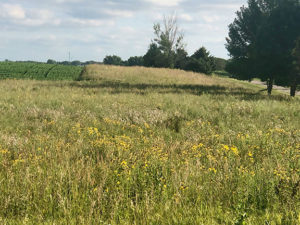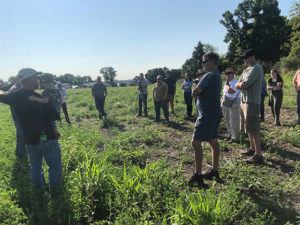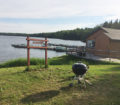
Mature prairie buffer strip located north of Reeds Run along the road protecting that portion of the east side of Big Spirit Lake from runoff. (photo by Steve Weisman)
By Steve Weisman
As I traveled last Thursday morning (August 8) for the Prairie Lakes Conference field tour on the newly acquired Wallace and Bowers Nature Area on the north side of Big Spirit Lake, I wondered what I would find. As I turned south on the entrance road to Shore Acres, I saw the traditional corn and bean fields you see all across northwest Iowa. Nothing different, I thought. However, as I learned throughout the morning, this was far from being a normal corn and bean operation. First, a little history.
How it became a nature area
The 160-acre Wallace and Bowers Nature Area was purchased by the Iowa Natural Heritage Foundation (INHF) in 2018 to be restored and managed primarily for water quality benefits. The generosity of two families made this possible: Jeff and Elizabeth Wallace and the children of Clifford and Sheila Bowers (Barbara Mendenhall, Abby Adams and Bert Bowers). However, it is not going to be simply tall grass prairie. Instead, it will be a working farm with a tenant who uses the best agricultural conservation practices available. Here is the rest of this exciting story.
Field tour
This property is adjacent to the north shore of Big Spirit Lake and has been cropland for generations. As I listened to Anita O’Gara, vice president of the Iowa Natural Heritage Foundation, she shared the foundation’s mission of restoring Iowa’s land, water and wildlife, the very reasons the INHF was so interested in this property. First off, everything drains to the lake. As a result, during big rain events, surface runoff into the lake can create an incredible amount of soil erosion and nutrients dumping right into the lake. Hence, this property is an extremely important piece of the puzzle in protecting Big Spirit Lake. This project will protect source water (drinking water), improve water quality in the entire Iowa Great Lakes system, increase habitat for wildlife habitat and may even offer recreational opportunities.
All of this will happen even as half of the land will still be farmed, but with great conservation practices. Most importantly, where the property runs along the lake a prairie buffer strip 100-150 feet wide has been planted with 110 different types of plants, ranging from prairie grasses to an array of forbs. This first year is a slow one for native plants, as their energy focuses on root growth. As a result weeds are a challenge, but several clippings will control that, along with controlling thistles. Even so, the prairie is beginning to show itself and within three years, the restoration will be exciting to see. (If you want to see an established prairie buffer, check out the east side of Big Spirit Lake north of Reeds Run, where the native prairie and forbs are doing an incredible job of limiting runoff into the lake).
To the north of the prairie, alfalfa has been planted and will be kept as alfalfa for five years. It will provide hay for cattle, will help eliminate synthetic fertilizers and put nitrogen back into the ground naturally, increasing the health of the soil.
Toward the road (north) are the traditional soybeans and corn…except they are not what they seem to be. The beans have been planted into a no-till practice with no use of chemicals, and they look great. Farm tenant Jake Johnson explained to us that the corn already has a cover crop (rye, turnips and radishes) planted that is just kind of sitting there until the corn plants mature and begin to dry out, and the sun gets to the cover crop. The cover crop will then begin growing but still be below the level to harvest the corn. The cover crop is grown primarily to hold the soil in place, increase water infiltration and help eliminate water runoff, help build and improve soil quality and suppress weeds.

Newly seeded prairie buffer strip on the south side of the Wallace and Bowers Nature Area. (photo by Steve Weisman)
The Iowa Lakeside Lab is leading water monitoring and analysis so data can be collected to learn how these changes on the land impact the water, soil and wildlife over time.
This fall one more conservation practice will be completed on the northwest corner of the property near the highway, where a wetland will be restored taking land out of production that most years drowns out and produces little to no revenue.
The crop rental income will help INHF pay the property taxes and complete the purchase of the land.
Even more exciting news
In addition to the Wallace and Bowers Nature Area, the INHF recently purchased three properties (fields) lying between the Wallace and Bowers Nature Area and Mini-Wakan State Park. As a result, land from Mini-Wakan State Park all the way to Trickle Slough Wildlife Management Area will now have conservation practices implemented that protect Big Spirit Lake.
The morning was a great opportunity for me to learn more about protecting our natural resources while still being able to maintain agricultural profitability.

















